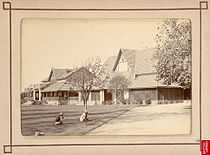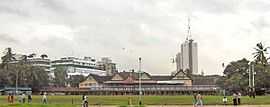Gymkhana

Gymkhana (Hindi: जिमख़ाना, Bengali: জিমখানা, Urdu: جِمخانہ, Sindhi: جمخانه) is an Indian term which originally referred to a place of assembly. The meaning then altered to denote a place where skill-based contests were held. "Gymkhana" is an Anglo-Indian expression, which is derived from the Persian word "Jamat-khana".[1] Most gymkhanas have a Gymkhana Club associated with them, a term coined during British Raj for gentlemen's club.
In India, the term gymkhana is commonly used to refer to a gymnasium. More generally, gymkhana refers to a social and sporting club in the Indian subcontinent, and in other Asian countries including Malaysia, Thailand, Burma and Singapore, as well as in East Africa.
In English-speaking countries, a gymkhana refers to a multi-game equestrian event performed to display the training and talents of horses and their riders. The plot of the children's story "The Mystery of the Invisible Thief" by Enid Blyton begins at a gymkhana held at an English village, testifying to its being a common institution in English society at the time of writing (the 1940s).
The term is also used as the name of a timed automotive obstacle course, see Gymkhana (motorsport) and Gymkhana (motorcycle).
Etymology

The first element of gymkhana comes from gend meaning ball in Hindi/Hindustani/Khariboli. This element is distinct from English word gym, short for gymnasium and gymnastics which has Greek and Latin roots.[2] The second element, khānā is Indo-Aryan (ख़ाना) for place or compartment and Persian (خانه) term for dwelling, house.[3]
Types of events
The main events of equestrian gymkhana include barrel racing, pole bending, flag race, key hole, and stake race. Some organizations even include ride and run, musical mats, egg stomp, $5 bill race, and sack race. All of these events challenge the horses and riders ability to work together, and demonstrate many skills such as speed, flying lead changes, sliding stops and more. It is suitable for all ages of people including the very young and very old.
See also
- Bombay Gymkhana
- Darjeeling Gymkhana
- Delhi Gymkhana
- Hindu Gymkhana
- Jamalpur Gymkhana
- Mauritius Gymkhana
- Karachi Gymkhana Club
- Lahore Gymkhana Club
- Gymkhana Ground, Rangoon
- Chennai Gymkhana Club
- Nairobi Gymkhana Club
- List of India's gentlemen's clubs
- Jorhat Gymkhana Club
- IISER K Gymkhana
References
- ↑ MacMillan, Michael (1895). The Globe Trotter in India Two Hundred Years Ago: And Other Indian Studies. p. 91.
- ↑ Oxford Dictionaries Gymnasium etymology
- ↑ From Loghat'nāmeh-ye Dehkhoda, Third Edition (Tehran University Press, 2006), quoted from Borhān-e Ghāte' by Dr Mohammad Moin.
External links
 Texts on Wikisource:
Texts on Wikisource:
- "Gymkhana". New International Encyclopedia. 1905.
- "Gymkhana". Encyclopædia Britannica (11th ed.). 1911.
| ||||||||||||||||||||||||||||||||||||||||||||||||||